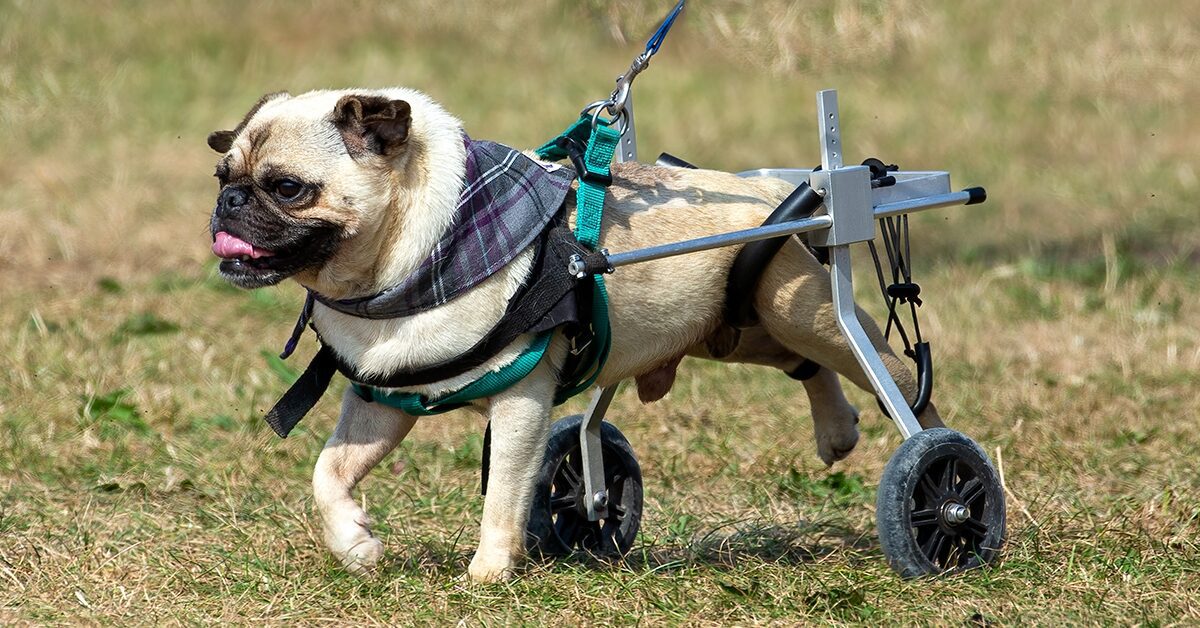Intervertebral disc disease, or IVDD, in dogs is the most common spinal disease seen in dogs. It’s a range of issues, all involving the degenerative changes that cause bulging or herniation of the intervertebral discs in your dog’s spine.
Some dogs are more prone to disc problems than others, but they can happen to any dog anytime. For the most part, IVDD is an age-related degenerative disease. Let’s take a deeper look at IVDD and see if your dog may be at risk, and what you can do to reduce those risks.
What is IVDD?
In between the bones that protect your dog’s spinal cord are discs called intervertebral discs. Those discs have two parts; the fibrous outer rim called the annulus fibrosis and the gelatinous center called the nucleus pulposus.
Discs play a role in stabilizing the spinal column so your dog can bend and twist and act as shock absorbers during physical activities such as jumping and running.
The spinal column protects the spinal cord and nerves running up and down the body. The impulses from those nerves control movement, sensation, respiration and body function like peeing and pooping.
When discs become damaged from trauma or through age-related degeneration, the outer layer can become compromised, allowing the gelatinous center to bulge, dehydrate or harden. The integrity of the disc is at risk if this happens.
When they become hardened (calcified), it compromises the shock absorbing capacity. With a rupture, or tear, the nucleus, or center of the disc, and even fragments of a damaged outer rim can push into the spinal canal, causing pressure on the spinal cord and nerves.
If this happens, your dog will experience anything from pain to complete paralysis, depending on how severe the disc damage is.
There are three types of IVDD, and depending on the severity of the problem, your dog may or may not require surgery. Let’s look at which dogs are more at risk for IVDD, and the IVDD types that are diagnosed by veterinarians.
Which dogs are at risk for IVDD?
Dogs with short, bowed legs and long backs (called chondrodystrophic breeds) are more likely to have disc problems. These breeds include Basset Hounds, Corgis, Pekingese, Shih Tzus, Dachshunds, toy and miniature Poodles, and Cocker Spaniels.
Some large breeds such as Dobermans, Labrador Retrievers, German Shepherds, and Golden Retrievers are also at risk for IVDD when they are adults and seniors (5-12 years old).
However, any dog can develop the condition. IVDD can come on suddenly because of disc herniations and ruptures, also called slipped discs, or following trauma.
Types of IVDD in dogs
Type 1: This type of IVDD is often seen in small breed dogs with short legs, but it can happen to any dog. It’s also called a slipped disc and can happen anywhere along the spine, but we commonly find it in the middle back (thoracolumbar IVDD).
Jumping, landing wrong, or twisting wrong can cause the disc to rupture, allowing the inner gelatinous material to bulge or herniate into the spinal canal and put pressure on the spinal cord.
This is a painful condition requiring immediate veterinary attention. Symptoms can range from severe pain to complete paralysis depending on how much pressure is on the spinal cord or if there is a spinal cord injury. Symptoms can include:
- Difficulty walking or controlling the hind limbs. If the rupture happens more toward the neck (cervical IVDD), there may be no control over all four limbs.
- Limping on one or both front legs
- Shivering or panting
- Hunched back or stiffness
- Urinary incontinence or loss of bowel control. Remember that the spinal cord carries all the nerves running up and down the spine. When injury or trauma interrupts those nerve impulses, complete paralysis can occur, affecting respiration, bladder, and bowel control.
- Weak or uncontrolled back limbs or all limbs, or dragging feet
- Loss of pain sensation
- Difficulty breathing or paralysis (this requires surgery)
Type II: This type of disc degeneration has a more gradual degenerative condition that may or may not cause pain. We find it in large breed dogs from 5 to 12 years old. The disc loses water over time, hardening and causing calcification of the annulus.
The chronic bulging of the annulus leaves it vulnerable to tearing or fragmenting. If the fragment buldges into the spinal canal, it will likely cause spinal cord compression. This type of disc degeneration will progress further as the dog ages.
Symptoms can be sudden like Type 1 or progressive over time, and include:
- Reluctance to exercise
- Difficulty rising or climbing stairs
- Reluctance to jump
- Stiff neck
- Increased irritability due to chronic pain
- Stiff walk with stiff or hunched back
- Difficulty holding position when eliminating (the walking poops)
Type III: The rarest type of IVDD occurs when the disc’s annulus or fibrous outer rim suffers a sudden tear or herniation, causing the nucleus to explode. Often, it occurs after trauma. This type is associated with a sudden onset of symptoms that are similar to Type 1.
Type III IVDD carry a poor prognosis because they are associated with severe spinal cord injury.
How is IVDD diagnosed?
If you notice that your dog suddenly seems in acute back pain, or is having difficulty moving, see your vet immediately. Your vet can resolve some minor incidences of IVDD with physical therapy and anti-inflammatory medications, but many require surgery to restore your canine companion’s comfort and movement abilities and prevent the problem from happening again in the future.
You won’t know the severity of your dog’s IVDD until your veterinarian has performed the following diagnostic tests and determined a course of treatment.
Physical examination and history: Your vet will want to know what you observed and when symptoms started. She will conduct a full physical exam including a neurological exam where she will pinpoint where the spinal cord is injured.
Lab tests: Blood count (CBC), urinalysis, and serum chemistry.
Spinal X-rays: To reveal any changes in the discs from disc disease. Calcification of the disc material or narrowing IVD space is visible in X-rays.
Advanced diagnostic imaging: CT Scans and MRIs can find abnormalities in the fibrous tissues, herniated discs, and muscles where X-rays just show bones and cartilage formations. When diagnosing IVDD, it’s important to rule out blood clots and tumors and look for any trauma to develop an effective treatment plan.
Treatment of IVDD
Treatment depends on the result of the diagnostic tests run by your veterinarian. Minor first-time cases with back pain only can be managed with anti-inflammatory medications and rest (strict crate confinement for 2-4 weeks). This will often restore dogs to their normal activities. The key to recovery is allowing the spine to recover without stress from normal activity.
More severe cases will require surgical treatment to decompress the pressure on the spinal cord and repair or remove damaged disc tissue. Most dogs recover well from IVDD surgery and return to their normal lives after a rehabilitation period of 6-8 weeks. However, some will not regain their limb movements, requiring a dog wheelchair to get around, which they tend to adapt to very well.
How can you prevent IVDD?
- Keep your dog at a healthy, lean weight to reduce stress on their spine and joints.
- If you have an at-risk breed, limit jumping by having stairs or ramps in your home and yard.
- Use harnesses during walks rather than collars to protect the neck, especially with dogs that pull.
- Dogs prone to IVDD can benefit from less strenuous exercise that may damage or strain their backs. Low-impact exercises like aqua therapy or swimming can strengthen muscles and tendons without straining them or risking injury. Be sure to use a lifejacket!
IVDD in dogs is a degeneration or injury of the vertebral discs in the dog’s spine. Some dogs are more prone to spinal and disc injury than others. When your dog is in pain, you want to be able to say ‘yes’ to the best care possible to relieve that pain. Enrolling your dog in a pet insurance plan with Pumpkin can help you do just that.




